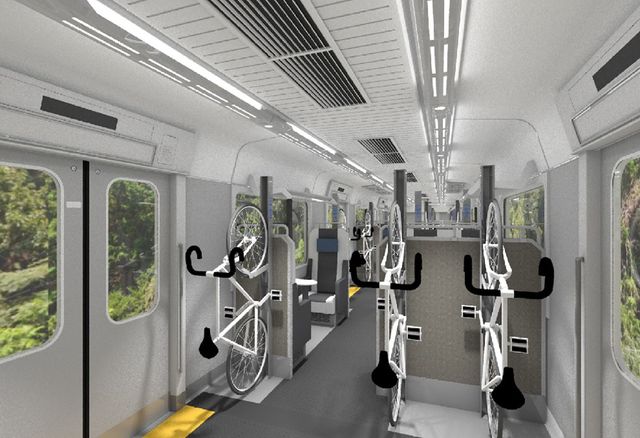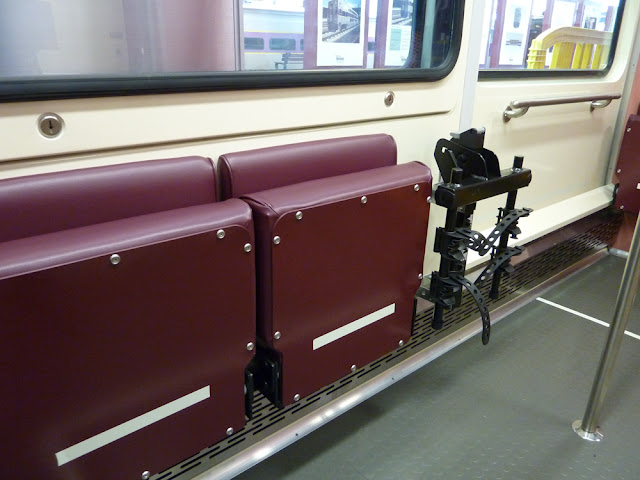General question for the board:
Does Boston have the ability (.....based on state funding laws) to create its own streetcar/tram system like in Kansas City or DC? I seem to remember hearing that Boston is reliant on the MBTA the way our political and funding system is setup. It always seems to me that a reasonable transit pitch would be some small starter streetcar system located completely within Boston such as Seaport, South Boston, Dorchester, etc. that is not controlled by the MBTA. I've seen so many nice small streetcar systems recently from Portland, Seattle, Kansas City, Oklahoma City, DC and others. I can never figure out why Boston isn't moving something forward? Castle Island to Broadway or Andrew as an example?
How is that better than a bus?
The biggest criticism of those systems is they are essentially just a bus replacement and trolleys can have higher capacity, but I don't know that something like that is what should be focused on now. Why not do the much simpler step of adding bus lanes to Broadway, A st., and Dorchester Ave some of the main roads used by the buses in the area. Plus that improvement could happen much sooner than a trolley without making it impossible to implement a trolley in the future if it made sense.
Not even "bus replacement"...most of those starter systems are just very limited-distance downtown circulators that link together bus nodes on different ends of the CBD that are problematically tough to link by any other means. Right mode for the job because high-capacity pipes are needed, but they generally aren't the seeds of systems that are going to grow to any great scope over time because the mission statement is pretty limited and most other pressing CBD-to-outer-neighborhood transit needs make the most hay taking a stab with bus optimization and BRT corridors first. And in the case of Washington D.C., because Metro does not 1:1 correspond with circulation patterns left underserved by the city's infamously abandoned streetcar network, so there was always a major flank left unfilled that HRT expansion couldn't scratch like new LRT seed-planting could. (Of course it would help if the modern D.C. Streetcar wasn't such a planning boondoggle, as actual execution doesn't aim very straight at the vacated need.)
Or, in even more limited scope, the streetcar is a heritage operation for the tourist district whose patronage weights much heavier to visitors than locals...such as Tampa's streetcar. It's an adorable little system and gooses their tourist revenues, but there's great frustration in Tampa...where
Old City Tampa used to be a rare genuine Southern streetcar city (in Florida-speak in "the pre- air conditioning years")...that it's so single-minded in scope that it signifies no major change in transit orientation (or modern total lackthereof) amongst civic planners.
Boston isn't conducive to the former, because the fact that we already have a legacy system means our primary diverging nodes in the CBD are already long-covered by high-capacity pipes. We have a backlog of modern congestion mitigation projects to build, and sorely missing circulator legs like Downtown-Seaport that desperately need to be tied to the existing system, but nothing requiring whole-cloth new seeding. Likewise, for all the talk about how nifty it would be to have a heritage streetcar between North Station and South Station on the Greenway...what is that actually serving in primary demand other than the visitors' market and a momentary excuse to break eye contact over the fact that we're still not advancing NSRL seriously enough? I mean...I get it, it's net-positive over nothing and feel-good to reopen the Haymarket portal and throw the Mattapan PCC's there for a Brattle Loop-Greenway run, but if we build Green Line to Transitway off Boylston where do you think daily commuters are going to be making that run? The Type 10 supertrain lash-up that thru-routes in from GLX and out from Boylston through the Silver Line Phase III replacement Transitway hookup and does NS-SS in 6 or 7 subway stops? Or the single-car heritage short-turn that's co-running in a striped bus lane through a dozen traffic lights? One's a nice-to-have attraction and badge of civic pride. The other is actually carrying a load-bearing 125 seats + standees every 6 minutes or less behind fare control through half-dozen transfer stops on rigid schedule adherence. Doesn't mean we can't someday have both for mutually complementing perfection...but ye gads, the priorities! I wish things like "Greenway trolley" were not so widely talked about, because too often it's under self-medicating duress as pivot away from talking about the five-alarm critical stuff we have to be building first for our survival.
Now...if you
do want a local example of where seed-planter LRT system could go, look to Lowell. It's already got the Lowell Trolley heritage streetcar run on the abandoned Canal freight trackage by an annex of Seashore Trolley Museum. There is enough not-yet-tapped additional trackage around the Canal district to substantially expand the system, and to tie it into the commuter rail station and future RUR service levels there into a major downtown circulator through juicy, juicy TOD...diverging LRTA nodes...and major UMass entrenchment across the city. And you can continue running it with historic stock by upping subsidy to Seashore and giving them better facilities to maintain fleets. Lowell actually would be a *perfect* landing spot for the Mattapan PCC's when they're displaced by Type 9's, as Seashore has the in-house expertise to keep maintaining the 8 cars while the T can't. ADA compliance can also be cheaply achieved by having front-door mini-high ramps like all Mattapan stops do (who cares if they're cheap wood for Lowell price ranges).
Of all LRT-bearing cities in North America, Lowell compares demographically most favorably with
Kenosha, WI whose heritage streetcar circulator similarly was used as a conduit for revitalizing an old canal district with TOD and linking to a busy Metra commuter rail station for commutes to Chicago. Their system, built from-scratch in 1998 (unlike Lowell Trolley which has been in operation on portion of the Canal trackage since '78) and runs in a complete circle east-west around the CBD. Fleet is a series of refurbbed ex-Toronto PCC's, and a streetcar museum is contracted to administer trolley ops while the local bus RTA handles the business side of the system. The build (after many doubters) performed so well that the city has been debating a self-funded major north-south extension of the system into a second concentric loop (unfortunately killed in 2017 by an austerity gov't elected to the Council, but it's expected to keep coming up again). Lowell took a serious look at pursuing study of turning the Trolley Museum into general-purpose transit starting with a looped extension to the CR station about 3-4 years ago, but demurred on the vote thinking it was too aggressive.
With RUR coming, they arguably weren't being aggressive enough. Expect that one to periodically get debated, and the advocacy to coalesce in trying to pry local pols off the fence about it. Most of the "not-Boston" streetcar debate in New England concerns Providence, where that circulator is embedded in a whole lot of BRT buildouts marking the downtown spine where BRT alone simply isn't enough load-bearing capacity for tying a bunch of other BRT routes together on either end of the CBD. Likewise what you'd call a "traditional" seeder system. Maybe some slight discussion of the same in Portland, although their prospects are fiscally a lot iffier and definitely not as tapped out on nearer-term bus capacity enhancements where the streetcar talk is way premature (unlike Providence). But we've all heard lots about what a big step Providence Streetcar is. Lowell is the much lower-impact seed-starter that unfortunately never gets talked about. The trolley's already been there as a semi-useful toy for 42 years...and the operator that can run a historic fleet is already in-place. The unused Canal trackage + city-landbanked Canal ROW's for massive system expansion are already in-place. The unused and rehabilitated trestle across the water to to the commuter rail station is already in-place. All it needs resource-wise is the scale-up push: the money to lay/rehab and electrify track, a 'native' half-dozen PCC's that can hold baseline service while the rotating exhibit of trucked-in Seashore museum pieces infills for the tourists + better shop space for maintaining them, the extra subsidy for paying Seashore to run the ops, the fare integration with LRTA and Commuter Rail with either LRTA running it as a business unit or some new city-level department taking up that task, the front-door ADA ramps at otherwise spartan street corner stations, and the 'vision thing' TOD coordination with a Development Authority on terraforming the Canal district around the new circulator.
Exactly the playbook that most-similar demographically Kenosha played for its launch.
There is low-risk precedent. I'd love it to death if Lowell just said "Right on; we're going for it!" because I think the odds of success and odds of it punching well above weight are very good at very managed risk. Not all such systems have to be big, deep-pocket productions like Providence's proposal in order to hit their mark. We've got a unique opportunity right under our noses in this state, and timing for action just so happens to very conveniently match when the T is going to be sunsetting those Mattapan PCC's off to Seashore any which way.



